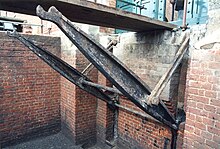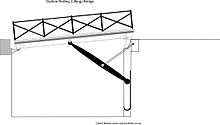
An axle or axletree is a central shaft for a rotating wheel or gear. On wheeled vehicles, the axle may be fixed to the wheels, rotating with them, or fixed to the vehicle, with the wheels rotating around the axle. In the former case, bearings or bushings are provided at the mounting points where the axle is supported. In the latter case, a bearing or bushing sits inside a central hole in the wheel to allow the wheel or gear to rotate around the axle. Sometimes, especially on bicycles, the latter type of axle is referred to as a spindle.

The Ackermann steering geometry is a geometric arrangement of linkages in the steering of a car or other vehicle designed to solve the problem of wheels on the inside and outside of a turn needing to trace out circles of different radii.
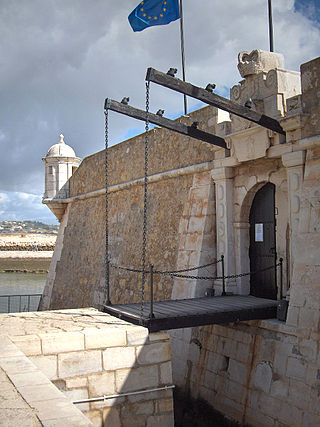
A drawbridge or draw-bridge is a type of moveable bridge typically at the entrance to a castle or tower surrounded by a moat. In some forms of English, including American English, the word drawbridge commonly refers to all types of moveable bridges, such as bascule bridges, vertical-lift bridges and swing bridges, but this article concerns the narrower historical definition of the term where the bridge is used in a defensive structure.

In automotive design, a front-engine, front-wheel-drive (FWD) layout, or FF layout, places both the internal combustion engine and driven roadwheels at the front of the vehicle.

A dump truck, known also as a dumping truck, dump trailer, dumper trailer, dump lorry or dumper lorry or a dumper for short, is used for transporting materials for construction as well as coal. A typical dump truck is equipped with an open-box bed, which is hinged at the rear and equipped with hydraulic rams to lift the front, allowing the material in the bed to be deposited ("dumped") on the ground behind the truck at the site of delivery. In the UK, Australia, South Africa and India the term applies to off-road construction plants only and the road vehicle is known as a tip lorry, tipper lorry, tipper truck, tip truck, tip trailer or tipper trailer or simply a tipper.

Rolling is a type of motion that combines rotation and translation of that object with respect to a surface, such that, if ideal conditions exist, the two are in contact with each other without sliding.

A tow truck is a truck used to move disabled, improperly parked, impounded, or otherwise indisposed motor vehicles. This may involve recovering a vehicle damaged in an accident, returning one to a drivable surface in a mishap or inclement weather, or towing or transporting one via flatbed to a repair shop or other location.
A flatcar (US) is a piece of rolling stock that consists of an open, flat deck mounted on a pair of trucks (US) or bogies (UK), one at each end containing four or six wheels. Occasionally, flat cars designed to carry extra heavy or extra large loads are mounted on a pair of bogies under each end. The deck of the car can be wood or steel, and the sides of the deck can include pockets for stakes or tie-down points to secure loads. Flatcars designed for carrying machinery have sliding chain assemblies recessed in the deck.

An anti-roll bar is a part of many automobile suspensions that helps reduce the body roll of a vehicle during fast cornering or over road irregularities. It connects opposite (left/right) wheels together through short lever arms linked by a torsion spring. An anti-roll bar increases the suspension's roll stiffness—its resistance to roll in turns—independent of its spring rate in the vertical direction. The first stabilizer bar patent was awarded to Canadian inventor Stephen Coleman of Fredericton, New Brunswick on April 22, 1919.

A moveable bridge, or movable bridge, is a bridge that moves to allow passage for boats or barges. In American English, the term is synonymous with drawbridge, and the latter is the common term, but drawbridge can be limited to the narrower, historical definition used in some other forms of English, in which drawbridge refers to only a specific type of moveable bridge often found in castles.

The Meigs Elevated Railway was an experimental but unsuccessful 19th century elevated steam-powered urban rapid transit system, often described as a monorail but technically pre-electric third rail. It was invented in the US by Josiah Vincent Meigs, of Lowell, Massachusetts, and was demonstrated from 1886 to 1894 in a suburb of Boston called East Cambridge.

An adhesion railway relies on adhesion traction to move the train. Adhesion traction is the friction between the drive wheels and the steel rail. The term "adhesion railway" is used only when it is necessary to distinguish adhesion railways from railways moved by other means, such as by a stationary engine pulling on a cable attached to the cars or by railways that are moved by a pinion meshing with a rack.
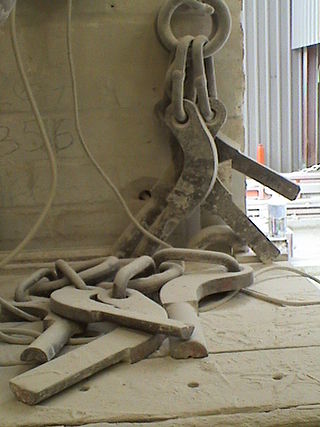
A lewis is one of a category of lifting devices used by stonemasons to lift large stones into place with a crane, chain block, or winch. It is inserted into a specially prepared hole, or seating, in the top of a stone, preferably above its centre of mass. It works by applying principles of the lever and utilises the weight of the stone to act on the long lever-arms, which in turn results in a very high reaction force and friction where the short lever-arms make contact with the stone inside the hole and thereby prevents slipping.

Fort Nelson, in the civil parish of Boarhunt in the English county of Hampshire, is one of five defensive forts built on the summit of Portsdown Hill in the 1860s, overlooking the important naval base of Portsmouth. It is now part of the Royal Armouries, housing their collection of artillery, and a Grade I Listed Building.

A ballast tractor is a specially weighted tractor unit of a heavy hauler combination. It is designed to utilize a drawbar to pull or push heavy or exceptionally large trailer loads which are loaded in a hydraulic modular trailer. When feasible, lowboy-style semi-trailers are used to minimize a load's center of gravity. Typical drivetrains are 6×4 and 6×6 but also available in 8×6 and 8×8. Typical ballast tractor loads include oil rig modules, bridge sections, buildings, ship sections, and industrial machinery such as generators and turbines.
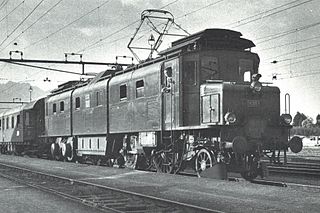
The Ae 4/8 was a prototype locomotive of the Schweizerischen Bundesbahnen (SBB) for the testing of electrical operation. The locomotive was equipped with two different drives, therefore acquiring the nickname Bastard. Because of its three-part locomotive body it also acquired the nickname Tatzelwurm.
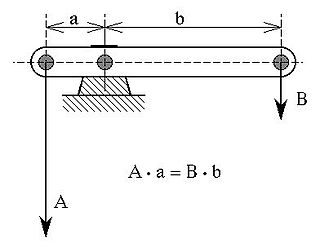
A simple machine that exhibits mechanical advantage is called a mechanical advantage device - e.g.:

The Hydroaéroplane Caudron-Fabre, (Caudron-Fabre), was a French amphibious seaplane that competed in the 1912 Monaco event. It was one of the first true amphibians, able to take-off from water and touch down on land.
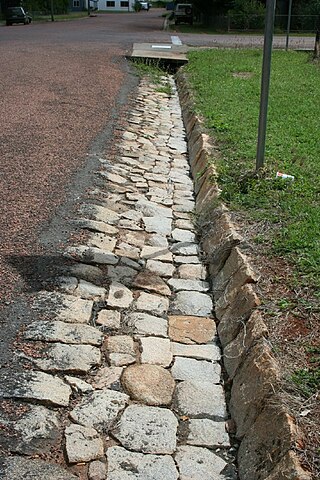
The Stone kerbing, channels and footbridges of Charters Towers is a heritage-listed group of water infrastructure at various locations in Charters Towers City, Millchester, Queenton, and Richmond Hill throughout Charters Towers, Charters Towers Region, Queensland, Australia. It was built from c. 1884 to 1930s. It was added to the Queensland Heritage Register on 7 February 2005.

A hydraulic modular trailer (HMT) is a special platform trailer unit which feature swing axles, hydraulic suspension, independently steerable axles, two or more axle rows, compatible to join two or more units longitudinally and laterally and uses power pack unit (PPU) to steer and adjust height. These trailer units are used to transport oversized load, which are difficult to disassemble and are overweight. These trailers are manufactured using high tensile steel, which makes it possible to bear the weight of the load with the help of one or more ballast tractors which push and pull these units via drawbar or gooseneck this combination of tractor and trailer is also termed as heavy hauler.
